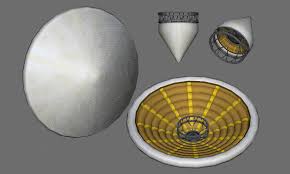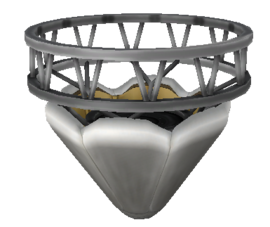Difference between revisions of "Heat Shield (10m)"
From Kerbal Space Program Wiki
AlpacaMall (talk | contribs) (reworded, added links, added jettison and drag info) |
|||
| (2 intermediate revisions by 2 users not shown) | |||
| Line 13: | Line 13: | ||
[[File:ksp heat sheild.jpg|thumbnail|left|The heat shield from several angles, as of its release in {{version|1.1}}.]] | [[File:ksp heat sheild.jpg|thumbnail|left|The heat shield from several angles, as of its release in {{version|1.1}}.]] | ||
== Trivia == | == Trivia == | ||
| − | * A smaller-scale inflatable heat shield was successfully tested by NASA in 2009 [http://www.nasa.gov/topics/aeronautics/features/irve.html#.Vxt04DB97IU], while a larger one | + | * An inflatable heat shield demonstrator (IRDT) and a Fregat upper stage equipped with an inflatable heat shield were test flown in 2000 by a cooperation of NPO Lavochkin, ESA, DASA, and EU. The test was mostly successful. [https://www.esa.int/esapub/bulletin/bullet103/marraffa103.pdf] [https://space.skyrocket.de/doc_sdat/irdt-fregat.htm] |
| + | * A smaller-scale inflatable heat shield was successfully tested by NASA in 2009 [http://www.nasa.gov/topics/aeronautics/features/irve.html#.Vxt04DB97IU], while a larger one (LOFTID) was tested in 2022 [https://www.nasa.gov/mission_pages/tdm/loftid/index.html]. | ||
* It appears to be able to float on Kerbin's water without flipping. | * It appears to be able to float on Kerbin's water without flipping. | ||
| − | * The heat shield is very draggy; this can be used to make [[aerobraking]] and [[aerocapture]] easier. However, it can also lead to aerodynamic instability. One way to fix this is to place a second Heat Shield (10m) on the back of the vessel, acting like a parachute. | + | * The heat shield is very draggy; this can be used to make [[aerobraking]] and [[aerocapture]] easier. However, it can also lead to aerodynamic instability. One way to fix this is to place a second Heat Shield (10m) on the back of the vessel, acting like a parachute or [[w:ballute|ballute]]. |
== Changes == | == Changes == | ||
Latest revision as of 01:57, 25 November 2022
| Heat Shield (10m) | ||
| Heat shield by O.M.B. Demolition Enterprises | ||
| Radial size | Large | |
| Cost | (total) | 2 400.00 |
| Mass | (total) | 1.500 t |
| Drag | 0.1 | |
| Max. Temp. | 3500 K | |
| Impact Tolerance | 9 m/s | |
| Research | | |
| Unlock cost | 6 400 | |
| Since version | 1.1 | |
| Part configuration | HeatShield.cfg | |
| Ejection momentum | 100 Ns | |
| Testing Environments | ||
| On the surface | Yes | |
| In the ocean | Yes | |
| On the launchpad | Yes | |
| In the atmosphere | Yes | |
| Sub-orbital | No | |
| In an orbit | No | |
| On an escape | No | |
| Docked | No | |
| Test by staging | No | |
| Manually testable | Yes | |
The Heat Shield (10m) is a large, inflatable heat shield used to protect parts from aerodynamic heating. Unlike other heat shields, the Heat Shield (10m) does not use ablator, instead relying only on its high temperature tolerance.
Before inflating, it has a radius of 2.5m. After inflating, it has a radius of 10m, as the name suggests.
Once inflated, it cannot be deflated. Like other heat shields, it can be jettisoned without the use of a decoupler.
Product description
| “ | Based on the design of a child's toy, this heat shield uses a set of inflatable rings covered with a thermal blanket to provide a generous 10-meter heat shield for reentry and deceleration and the aerodynamic qualities of an untethered bouncy castle. — O.M.B. Demolition Enterprises |
” |

The heat shield from several angles, as of its release in version 1.1.
Trivia
- An inflatable heat shield demonstrator (IRDT) and a Fregat upper stage equipped with an inflatable heat shield were test flown in 2000 by a cooperation of NPO Lavochkin, ESA, DASA, and EU. The test was mostly successful. [1] [2]
- A smaller-scale inflatable heat shield was successfully tested by NASA in 2009 [3], while a larger one (LOFTID) was tested in 2022 [4].
- It appears to be able to float on Kerbin's water without flipping.
- The heat shield is very draggy; this can be used to make aerobraking and aerocapture easier. However, it can also lead to aerodynamic instability. One way to fix this is to place a second Heat Shield (10m) on the back of the vessel, acting like a parachute or ballute.
Changes
- Moved from Aero to Thermal
- Added ModuleLiftingSurface
- Initial release
